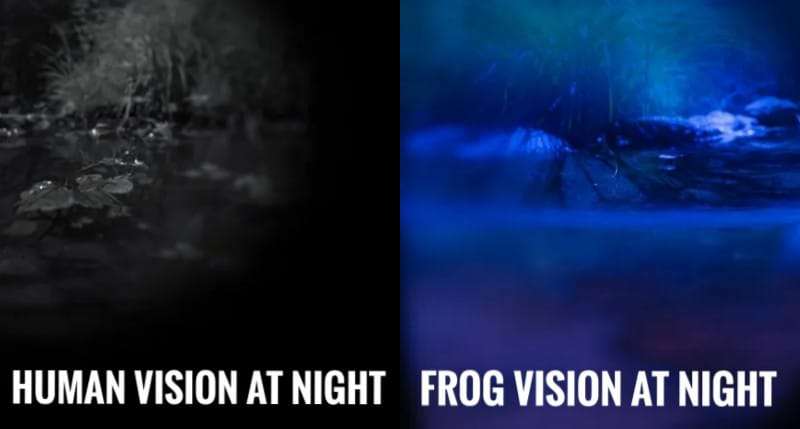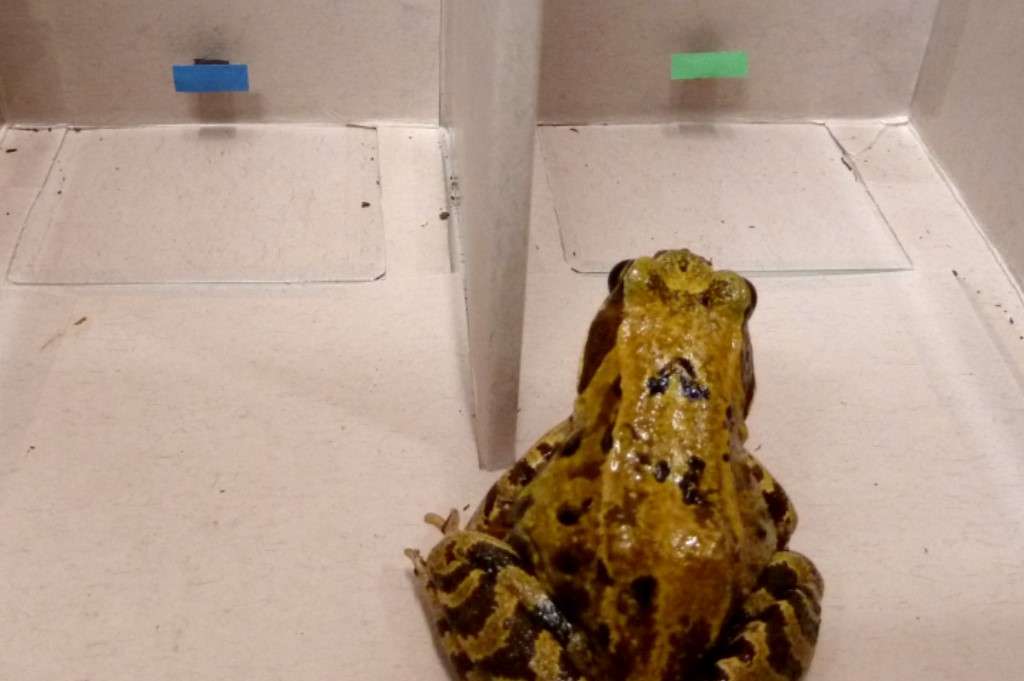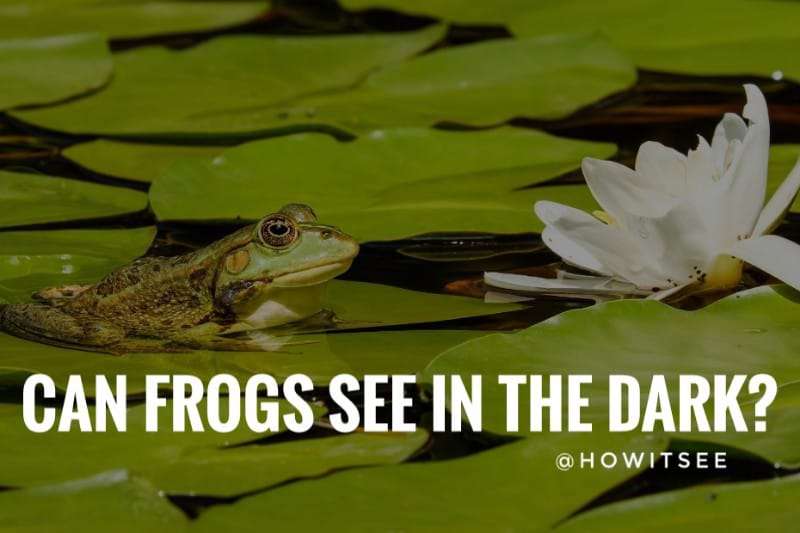Frogs are a member of tailless amphibians that have been evolving since the Permian period. There are more than 7,000 species of living frogs, and most of them have a distinct vision. Therefore, we have shared our knowledge of Frogs’ vision and their ability to see at night with colors.
The answer to the question, “Can Frogs see in the dark,” is: Frogs can see in the dark much better as compared to any other animal. Their eyes have a thin layer of tapetum lucidum and two types of sensitive rods that qualify them to see at night with colors.
They have the ability to perceive colors in the dark, whereas humans are not able to spot different objects.
Frogs’ eyes can sense a more comprehensive range of electromagnetic spectrum compared to humans. However, it depends on their species. Later in this post, we have explained more about frogs’ vision and other relevant queries in detail. So, let’s begin.
Can Frogs See at Night?
Frogs can easily see at night with the help of tapetum lucidum and rods in their eyes. Many amphibians, like frogs, have a thin layer of reflective tissue in their eyes that helps to reflect even the slightest of light directly at rods.
It is called tapetum lucidum and enables them to glimpse in the dark. But it primarily depends on their species.
According to the research done by Natural History Vision, many nocturnal frogs lack ultraviolet filters in their eyes. It enables them to sense ultraviolet light in the dark.
However, diurnal frogs have a UV filter that blocks ultraviolet light from entering their eyes. Their eyes are more sensitive to trichromatic colors like humans.

Also, recent studies have unveiled frogs have a unique ability to perceive colors even in the dark. Researchers from Lund University in Sweden surface that frogs or toads have superior night vision.
In the dark, where humans are not able to distinguish the shapes, frogs have the capability to recognize not only the shapes but even identify the colors of the various entities.
Explanation behind

The human eye comprises rods and cones. Cones help to distinguish millions of color shades, whereas rods help to perceive the amount of light, like brightness.
Cones need light to sense colors; that’s why we can only see the shape of the objects in black and white shades at night.
In contrast, the frog eye also comprises rods and cones of similar function, but their rods are extra responsive to light. They have rods with two different sensitivities. One is used to perceive the minimal amount of light, and the other is made to discern colors.
This unbelievable behavior is seen only in toads and frogs. Not only this, but they can also recognize colors even in the extreme darkness, down to the absolute threshold of the visual system.
Frogs predominantly rely on their vision and color-sensing ability to carry out their day-to-day activities like hunting for food, searching for mates, or identifying different species of frogs.
They also have to pass through various dark dens or underground passageways, so to navigate, they evolve their vision to sense color even in complete darkness.
In a nutshell, most frogs have excellent night vision with colors and can even see through the ultraviolet spectrum. However, it all depends on their species.
How do Frogs See the World?
Frogs see the world in millions of color shades similar to humans but in less clarity. Also, they are more sensitive to specific hues compared to others. Both humans and frogs are trichromatic and perceive colors of all three wavelengths, small, medium, and large.
But during the day, frogs are more prominent in certain tones like blue-green and the least in red. Also, due to the absence of ultraviolet filters, some frogs witness the world predominately in bright ultraviolet light with colors.

At night, all species of frogs have superiority over human eyesight. They have tapetum lucidum, lack of ultraviolet filter, and have more sensitive rods in their eyes that allow them to see colors in the dark.
Also, frogs can differentiate colors much better than humans. For them, it’s a need to survive, from hunting for food to finding mates and recognizing their enemies.
But in terms of clarity and contrast, human eyesight has the upper hand. We see the world in clarity with more details. In comparison, frogs have a wide field of vision with less depth perception.
Also, they can see well at a certain distance, and their eyes are more responsive to the movement. Therefore, like snakes, most predators hunt them by staying still and calm.
Depending on the species to species, many adult frogs experience living in both terrestrial and aquatic. Hence, they have developed their eyes to see in air and water, but they have to lessen the details to attain this wide range of accommodation.
Frogs are not able to see well in both environments. In water, they are hyperopic, and on the surface, they are myopic.
What Colors do Frogs See? (Can Frogs see color)
Frogs are trichromatic and can see various color variations. The cones in their eyes are responsive to blue, green, and red colors. But they have difficulty sensing red shades.
Frogs perceive a wide range of spectrum with blurrier vision; hence, the colors are more homogeneous and have less clarity than human eyesight.

Like humans, frogs can also comprehend distinct colors but with fewer details. Also, they have 360 degrees field of view and peripheral vision that assists them in spotting predators and prey efficiently.
Can Frogs see Humans?
Frogs can see humans, and they distinguish us from other animals. Amphibians and reptiles do not exhibit emotions and sense humans as a danger. However, if you pet them, they crave warmth and have adapted to being in close proximity to humans, then they do not show fear responses.
It’s true that frogs have color vision, but they cannot see the world similar to us. Therefore, it’s very difficult for them to recognize different humans only with their visual abilities.
Also, it’s impossible for them to perceive the world with details. The human eye is one of the best eyes among all animals to glimpse the surrounding with colors and details. In terms of clarity, only eagles can challenge us.
Do Frogs have good eyesight?
Frogs have good eyesight compared to humans in terms of night vision and color perception. They also have peripheral eyesight with 360 degrees field of view. But they are near-sighted and witness the surrounding with fewer details in blur vision.
However, in terms of detailed vision and clarity, humans are far much superior to frogs. Frogs lack details in exchange for night vision and better color perceptions. Hence based on different circumstances, both eyesights are great.
Frog Vision vs. Human Vision
| Frog Vision | Human Vision |
| Frogs are trichromatic and can see blue, green, and red color shades. | Humans are also trichromatic and can see blue, green, and red color shades. |
| Some species of frogs can detect ultraviolet light. | We cannot detect ultraviolet light. |
| Frog vision is a blur. | Humans have a clear vision and can see details. |
| Frogs can see much better in the dark. | We cannot see in the dark. |
Frogs possess unique visual abilities that allow them to perceive their surroundings both during the day and at night, although their night vision differs from that of humans and other animals.
While frogs are not considered true nocturnal animals, they have certain adaptations that help them see in low-light conditions. Their eyes contain a higher concentration of rod cells, which are more sensitive to light and are responsible for vision in dim environments.
This enables frogs to detect motion and navigate their surroundings even in the absence of bright light. Additionally, some species of frogs have a tapetum lucidum, a reflective layer behind the retina, which enhances their ability to see in low-light conditions.
Frogs also possess color vision, although it may not be as advanced as that of humans. Their retinas contain different types of cones that are sensitive to various wavelengths of light, allowing them to perceive certain colors.
However, the extent to which frogs can discern colors and the specific range of colors they can see may vary among species.
Overall, while frogs may not possess the same level of night vision as nocturnal predators, their visual adaptations enable them to function effectively in dimly lit environments.
These unique capabilities contribute to their survival and success in various habitats, as they rely on both vision and other sensory systems to locate prey, avoid predators, and navigate their surroundings.
Here, we conclude our article on “Can Frogs See in the Dark,” and Frogs’ vision. We hope you like our knowledge on this topic. We will be back with another post. Till then, stay tuned with us and read the articles below.
Frequently Asked Questions
Q1. Can Frogs see the red light?
Ans. Frogs can see the red light or not is totally dependent on its wattage.
References-
- Frog Vision by A.Z. ANDIS ARIETTA
- Frogs have unique ability to see colour in the dark by Lund University
- How do frogs see in the dark by Natural History Museum.
Also Read:

Meet Abhidept (nickname Monty), the visionary founder of How It See, being an engineering student, he’s fueled by an insatiable curiosity about the world around him. He is captivated by an eclectic correlation between animal groups, science, and nature, and this fascination drives his quest for understanding.
After completing his degree, he’s set on a mission to delve deep into the realm of nature, accumulating knowledge to share with you through his writing. In the meantime, he loves to watch anime and read anime.
